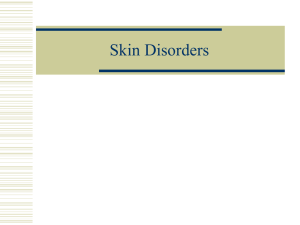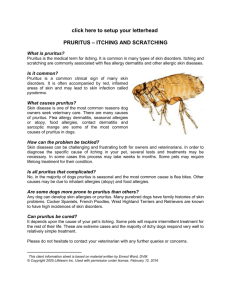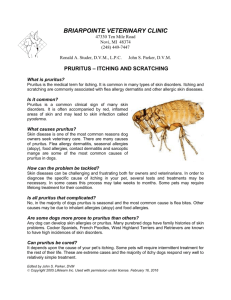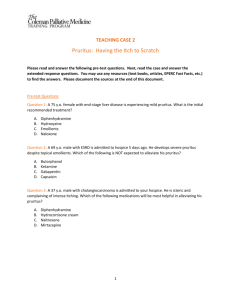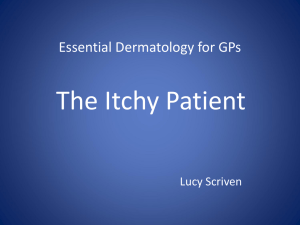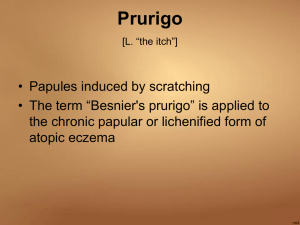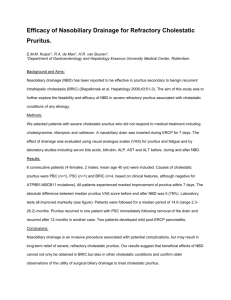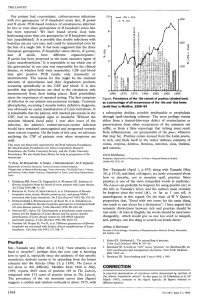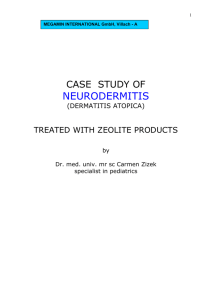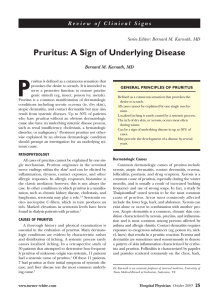PRURITUS (Itching without a rash)
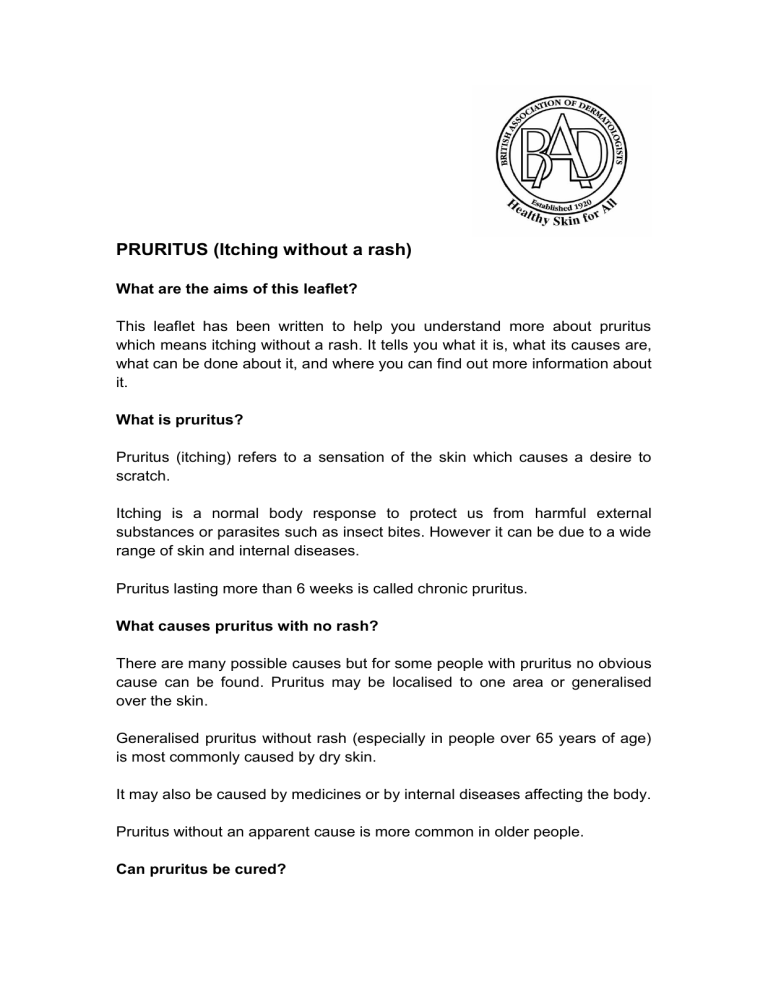
PRURITUS (Itching without a rash)
What are the aims of this leaflet?
This leaflet has been written to help you understand more about pruritus which means itching without a rash. It tells you what it is, what its causes are, what can be done about it, and where you can find out more information about it.
What is pruritus?
Pruritus (itching) refers to a sensation of the skin which causes a desire to scratch.
Itching is a normal body response to protect us from harmful external substances or parasites such as insect bites. However it can be due to a wide range of skin and internal diseases.
Pruritus lasting more than 6 weeks is called chronic pruritus.
What causes pruritus with no rash?
There are many possible causes but for some people with pruritus no obvious cause can be found. Pruritus may be localised to one area or generalised over the skin.
Generalised pruritus without rash (especially in people over 65 years of age) is most commonly caused by dry skin.
It may also be caused by medicines or by internal diseases affecting the body.
Pruritus without an apparent cause is more common in older people.
Can pruritus be cured?
When pruritus is a symptom of an internal disorder, treatment of this will sometimes lead to resolution of itch. Stopping a causative drug can lead to resolution of pruritus. Treating dry skin can improve pruritus but the treatment will need to be ongoing.
What tests can be done to find the cause for pruritus?
If a skin condition is suspected, a skin biopsy may be necessary. Your
Dermatologist or doctor may request blood tests to look for potential underlying medical conditions. A chest X-ray may also be taken.
How can pruritus be treated?
Moisturisers (emollients) : These should be applied several times every day to help the outer layer of your skin function better as a barrier to the outside world. The drier your skin, the more frequently you should apply a moisturiser.
There are many different types of moisturisers varying in their degree of greasiness, and it is important that you choose one you like to use. The best one to use is the greasiest one you are prepared to apply.
Aqueous cream was originally developed as a soap substitute. It is often used as a moisturiser but can irritate the skin in some people and make itching worse. For this reason aqueous cream is not the most effective moisturiser in dry skin problems. However, aqueous cream containing menthol (peppermint) is helpful to many people without dry skin as an anti-itch cream.
Anti-itch creams : Some creams containing anti-itch agents in addition to their moisturising effect can be bought over the counter, such as creams containing crotamiton or lauromacrogols). Your doctor may prescribe other creams such as doxepin cream, which has antihistamine action when applied in cream form.
Topical steroid creams or ointments: These will usually settle the redness and itching when there is an active inflammatory skin condition.
Antihistamines: An antihistamine tablet or syrup can help to improve some causes of pruritus. Non-sedating antihistamines may be of help in some patients. However, those that work best for chronic pruritus are sedating antihistamines which may cause drowsiness (so should not be taken if you plan to drive or use machinery) and are best taken at night before bed.
Some antidepressant tablets, prescribed by your doctor, taken at night can help you sleep if it is disturbed by itching.
Reversing habits: Pruritus can lead to a cycle of itching and scratching that can develop into a habit and be very hard to break. Identifying the times of day and the activities when scratching occurs most, may help you change your behaviour.
Phototherapy: Ultraviolet light treatment, given in the hospital can help to reduce pruritus or the itch/scratch cycle. ( More information in the phototherapy patient information leaflets)
Self care (What can I do?)
Anything you can do to take your mind off the itching will help to reduce or stop the scratching.
Try to avoid situations where you tend to scratch by changing your habits.
Try patting the skin instead of scratching.
Avoid soaking in baths for long periods as hot water may remove the natural oils from your skin.
Bathe or shower quickly in tepid (not hot) water no more than once daily.
Avoid using soaps or foaming body washes even if they claim to be good for dry itchy skin. Many of these contain detergents which remove natural oil from the skin.
You may find that laying a cool flannel soaked in moisturising cream on the skin can reduce the feeling of itch. A cooled emollient (moisturiser)
which has been kept in the refrigerator may also help.
Keep your bedroom cool and do not sleep with heavy or heat retaining
bedclothes. If you are hot and itchy during the day a fan can help to cool the skin down.
Emollients (moisturisers).
People with pruritus usually have dry skin, and therefore emollients may help to moisturise dry skin. They ease itching, reduce scaling, soften cracked areas and help the penetration of other topical treatments. There is a wide range of moisturisers available from pharmacists and supermarkets. There is usually no advantage in buying expensive moisturisers.
Where can I get more information?
Web links to detailed leaflets: http://www.dermnetnz.org/systemic/itch.html
http://www.patient.co.uk/health/itch
For details of source materials used please contact the Clinical Standards
Unit ( clinicalstandards@bad.org.uk
).
This leaflet aims to provide accurate information about the subject and is a consensus of the views held by representatives of the British
Association of Dermatologists: its contents, however, may occasionally differ from the advice given to you by your doctor.
This leaflet has been assessed for readability by the British Association of
Dermatologists’ Patient Information Lay Review Panel
BRITISH ASSOCIATION OF DERMATOLOGISTS
PATIENT INFORMATION LEAFLET
PRODUCED OCTOBER 2013
REVIEW DATE OCTOBER 2016
